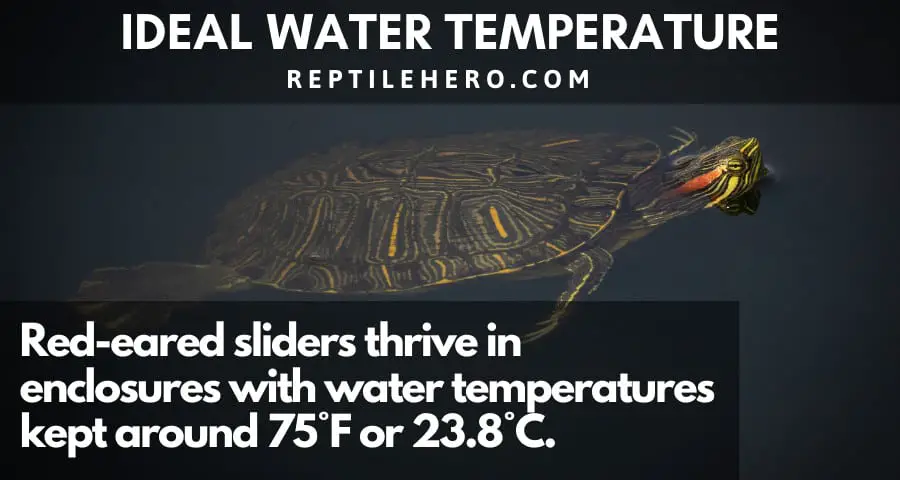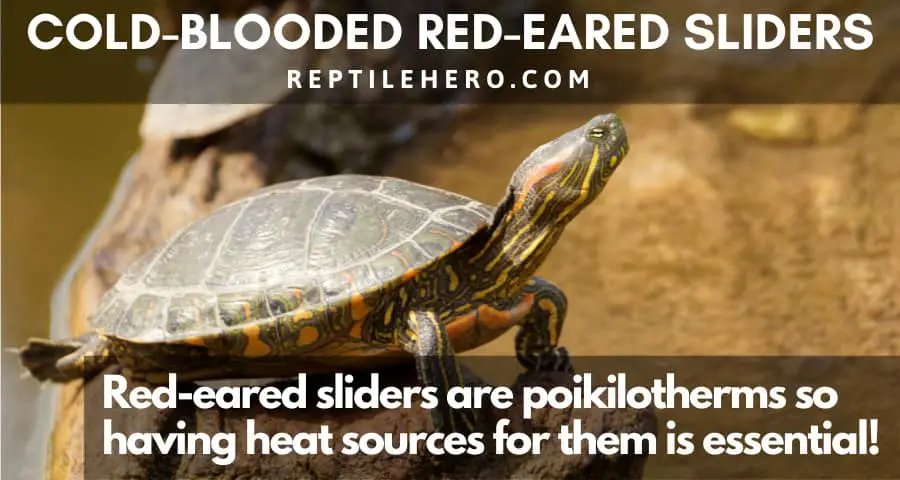Can Red-Eared Sliders Survive in Cold Water? (3 Best Temperatures)
Did you know that red-eared sliders sold in pet stores usually don’t survive the first year of their lives? Sadly, the number one cause of death for these unfortunate turtles is cold water in their tanks.
Generally, red-eared sliders cannot survive swimming for long in cold water with temperatures below 50 °F. They do best in water temperatures ranging from 70 to 88 °F depending on age and health conditions. Red-eared sliders will first become sluggish and eventually die if left in cold water.
Red-eared sliders are quite tough animals no matter how cute they might look in your tank. Despite their innate hardiness, however, they are still vulnerable to cold water. How much? Let’s find out!
What Temperature is Too Low for Red-Eared Sliders?
Overall, water temperatures from 65°F to 70°F (18.3°C to 21.1°C) are considered too cold for red-eared sliders. Although they can still survive at these water temperatures, keeping them for too long in such a cold environment will eventually lead to organ failure which can be fatal.
At 50°F to 65°F (10°C to 18.3°C), your turtle can seriously get stressed out. If this was your slider’s tank’s ambient temperature, your turtle will dig a hole into the substrate and go into brumation. When this happens, they will stay relatively dormant and you won’t be able to see them as often as you would like.
But it’s a completely different story if this was the temperature of your turtle’s water in the tank and they have nowhere else to go to for escape. This is especially true for very simple, if not lacking, beginner set-ups.
Anything below 50°F (10°C) can lead to shock in your red-eared slider’s system. This is highly intolerable for red-eared sliders and most other turtle species commonly sold as pets today. So make sure to have good, reliable thermometers and thermostats around to be able to monitor and control your slider’s tank temps!
Learn more about thermometers in our article on choosing the best thermometer.
Now, if you’re looking for that sweet spot where your red-eared sliders are comfortable in the waters they swim in, then look no further! I’ve got the answer you have been searching for.
What is the ideal water temperature for red-eared sliders?
The average red-eared slider requires an enclosure with water stable temperatures kept around 75°F or 23.8°C. This temperature level is acceptable for fit hatchlings, juveniles, adults, and even sick turtles.

But if you want to learn about the ideal specific temperature ranges for each age level, then check out the next sections for the guides!
3 Best Temperature Settings for Your Red-Eared Sliders
Below, you can find the 3 best temperature settings for your red-eared sliders based on their age, metabolism, and overall physical condition. You will notice that younger turtles have a specific water temperature range for them to be able to thrive in captivity. Adult turtles, on the other hand, are not as demanding.
1. Hatchlings or Sick Turtles: 78‒82°F (25.5‒27.7°C)
in general, hatchlings and sick red-eared sliders need a higher water temperature falling within 78‒82°F (25.5‒27.7°C). This is essential for them to metabolize their food properly and for their bodies to function optimally.
At this stage, hatchlings are still insecure and prefer to stay in the water than go up on land so they can escape quickly if they feel threatened.
This is how they normally behave in nature as a survival strategy. So you can expect the same behavior from captive red-eared sliders too.
Sick turtles on the other hand need this for them to remain active enough so they’ll continue to feed and recuperate at a faster rate.
2. Juvenile Turtles: 74‒76°F (23.3‒24.4°C)
Conversely, juvenile red-eared sliders that have not yet fully matured will do well in water temperatures between 74°F and 76°F.
Juvenile turtles don’t need as much heat as they will spend their time equally in the water and on land. Still, it’s best to keep their water temperature within the 75 °F range to keep it at optimal conditions.
3. Adult Turtles: 70‒88°F (21.1‒31.1°C)
In general, adult turtles need water temperatures that cover a wide range for health and reproductive reasons. Since this is a very dynamic range, it is best to create a temperature gradient from 70°F to 88°F for the water they swim in.
When provided with a temperature gradient, your turtles can then choose the ideal temperature they want to swim in. This is much better than giving them a uniform water temperature throughout their tank!
What is a temperature gradient?
The temperature gradient system is what professional herpers use to refer to the practice of creating different temperature areas in reptile enclosures. Normally, this consists of a cool, middle, and warm area.
Learn more about temperature gradients in our article on the best heating set-up.
A reptile keeper can provide temp gradients in their pets’ tanks by installing a series of heat sources—and/or cooling devices—operating at slightly different temperatures.
In doing so, their geckos, snakes, and turtles can find the area they find most ideal for their needs. This is similar to what they would experience in their natural habitats.
How to Maintain the Right Water Temperature in Your Tank
Keepers and breeders can maintain the right water temperature in reptile tanks by getting a properly rated thermometer and an appropriate-sized water heater. This can help monitor the water temperature at a glance and adjust as needed.
If the water’s temperature dips below 75 or 74 °F (23.8 or 23.3 °C), it’s time to raise the heat level of your water. If the temperature in your tank’s water consistently goes beyond 88 °F, it’s time to get your turtles out and investigate further.
Other factors to keep in mind for easy temperature control include1) tank placement, 2) faulty water heater, 3) other hot objects, and 4) a broken thermometer.
1. Tank Placement
Avoid placing your red-eared sliders tank in an area with direct and generous sun exposure.
Placing your tank near a window will quickly heat your entire tank making it very uncomfortable for your pets if they have nowhere to hide or cool off.
Heat can also transfer into the tank if you place it against a wall that receives a lot of sunlight.
Worried that your turtle’s not receiving enough sunlight? A UV-B basking lamp is your solution! This will help them synthesize the Vitamin D3 and calcium in their diets. If you want them to have some sun exposure, take them out into the yard now and then.
2. Faulty Water Heater
Your water heater could be broken or damaged, so make sure to regularly inspect it.
A good quality water heater is enough to heat your tank’s water to the appropriate temperature. All you have to do is consider the age and physical conditions of your turtles to set the temperature right.
3. Hot Objects
Another cause for unnecessary heat build-up could be if you have a stove or fireplace nearby.
Any heat-emitting objects/appliances near your turtle’s tank can significantly boost temperatures to dangerous levels.
4. Broken Thermometer
Then again, you could also have a broken thermometer and that’s why I recommend you get the simplest one so that it doesn’t break down due to its complexity and only does one thing: monitor the water temperature.
Just make sure that the thermometer you get is waterproof!
Will Your Turtle Die in Cold Water?
Red-eared sliders will slowly die, often by drowning, if left swimming in cold water for extended periods. The main reason behind this is their biological tendency to match their surrounding temperature (poikilotherms) which also greatly affects their metabolism.

In extreme cold, a turtle’s metabolism and blood circulation will slow down to conserve heat and energy. Combining this with the continued swimming will deplete your turtle’s energy reserves leading them to sink to the bottom to rest.
The sad thing is, they might not have enough energy to get back up and they’ll end up drowning, unable to breathe at the bottom of the tank. Certainly, you don’t want that.
Note: This is only applicable to conditions wherein the water’s temperature is below 50 °F (10 °C) and the turtle has nowhere to go.
Learn more about the importance of heat for reptiles in our article on why geckos feel cold.
This usually happens to beginners who keep their turtles in small and simple fish tank set-ups with no basking area or dock to rest on and no water heater or filter to control the temperature and clean the water.
Further Questions;
Can red-eared sliders live in outdoor enclosures and tanks?
Red-eared sliders can live in outdoor tanks only if they are properly sheltered from the harsh elements. Moreover, they are native to the Southern part of the United States and Mexico. So in relatively warm areas, they can be kept in ponds. For sudden temperature drops, move them inside or provide a substrate they can burrow into for brumation.
How can you increase your turtle’s lifespan?
The key thing to maximizing a turtle’s lifespan is to minimize the factors that could lead to death. Additionally, you can increase your pet’s rate of survival by staying updated with the proper tools and information on improved husbandry standards.
Summary of Cold Water for Red-Eared Sliders
Red-eared sliders are vulnerable to changes in the water temperature. As poikilotherms, their bodies will involuntarily adjust to the water temperature they are swimming in.
If the water a turtle is in gets too cold (below 70°F or 21.1°C), they will enter into a state of sopor or brumation. Prolonged exposure to such environmental conditions can lead to internal organ damage and death by drowning and exhaustion for red-eared sliders.
Proper equipment such as thermometers and water heaters are a relatively small investment in exchange for a red-eared slider’s overall well-being in captivity.

